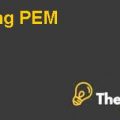
BACKGROUND
The report presents a case about Renault Trucks, which is one of the leading truck manufacturers in the world. The company had been incorporated in 1894 and was engaged in the designing and production of single cylinder engine. Later on, the company started to manufacture petrol-driven cars and trucks, which resulted in incredible success and enabled the company to achieve its corporate objective.
In the year 1955, Renault Trucks merged with Somua that formed Saviem. In 1978, Saviem merged again with Berliet to form the sole remaining French truck manufacturer, which was named as Renault Vehicles Industrials (RVI) that is a commercial manufacturer branch of Renault Group. The group enjoyed tremendous success and they continued to expand its operations internationally by acquiring Dodge Europe and the American brand Mack.
In 2001, the company became a part of Volvo Group, which is one of the largest European truck manufacturers and in the same year the company adopted new international trade name of “Renault Trucks”. The newly formed company was engaged in the manufacturing of high quality trucks and was also engaged in the manufacturing of spare parts. Remanufacturing industry was growing with incredible popularity because they are price sensitive, which provides low cost to the truck owners.
PROBLEM STATEMENT
The management was concerned about the investment in remanufacturing business. The machinery installed in the plant is either old, inefficient or the plant is running at full capacity, which raises concern for management because the company was failing to cope with the increased demand. Remanufacturing industry is a growing industry, so it’s important for the management to exert heavy funds in the remanufacturing division, so as to cope with increased demand.
OPTIONS AVAILABLE
Apart from truck manufacturing business, the company also tried to achieve tremendous success in the remanufacturing business, so the company designed a proposal that identified the deficiencies in the plant and also suggested the proposal for its consideration to the strategic management, so that they could take effective decision and comply with long-term objectives of the company.
In doing so, the company designed an executive program at IMD, in which the management representatives of the company surveyed the market, benchmarked competitors and assessed the capability of the Renault’s Trucks in the remanufacturing business. The management of the company confirmed that the proposed segment offers attractive opportunity but on the other hand, the management of the company also found that it conflicts with truck dealers and divest resources from most profitable original parts business. The management was concerned about this issue and was considering adopting a strategy, which may not result in sacrifice of either of opportunity.
After having a thorough analysis, the management of the company proposed three options. The first option is to outsource the activity to the third party, the second option is to expand and streamline the existing plant and the third option is to build an entirely new plant.
In order to evaluate the outsourcing option, the company has to evaluate whether it would be cost effective for the company to outsource and it would be successful to sell the reprocessed parts at increased profit margin. In order to evaluate the second and third option, the company has to determine whether it would generate sufficient cash flows if the company invested in improving the existing plant or develop a new plant.
GROWTH AND DEVELOPMENT
Renault Trucks operations became the second largest segment in the Volvo Group. The company offers wide range of trucks for its different segment, which ranges from heavy trucks that offers wide range of vehicles to distribution in the city to long-haul heavy trucks and military vehicles. The company’s operations are exercised in around 80 countries with a wide range of sales and distribution centers, subsidiaries and importers.
The company employed around 15,000 employees around the world and had strong network in Europe with 1,500 sales and service points. The company has owned about 32 dealerships of which 146 were owned by Renault Trucks in the French Market.
The prime motive of the acquisition of Renault Trucks by Volvo Group is to form the largest European truck manufacturer. The industry was increasingly moving towards remanufacturing the existing parts, which would benefit the truck owners because it is economically cheaper than the new parts. Remanufacturing include: activities of rebuilding used parts to achieve the maximum performance on a par with or just below new parts. Currently, the remanufacturing segment of Renault Group reports around 16% of the total company’s revenue.
INTERNAL STRENGTH AND WEAKNESSES
Renault Trucks has been known to employee around 15000 people, which gives it the advantage of human resources, physical resources. In addition, its presence in 80 countries that are connected with each other through a network of sales and service centers that gives it the advantage of financial resources, the company holds ................
This is just a sample partial case solution. Please place the order on the website to order your own originally done case solution.













